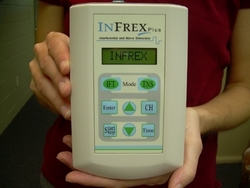Glial Cell Theory Might Explain Carryover Pain Relief As Revealed in This MedFaxx Video
All pain is in the head, which is the only place pain can be perceived, but what are the mechanisms that deliver the impulse to the brain is the answer to understanding how to control pain. Bob Johnson of MedFaxx describes the 3 leading chronic pain theories in this video, including the latest glial cell theory. The Glial cell theory may be the leading theory for explaining how interferential therapy is capable of providing extended carryover pain relief for many chronic pain patients.
|
|
Wake Forest, N.C. October 6, 2009 --

The chronic pain patient who suffers from diagnosis such as sciatica, osteoarthritis, RSD, phantom limb pain, low back pain, neck and shoulder pain and certain neuropathic conditions is often told "it's all in your head" according to reports over 30 years by chronic pain patients to MedFaxx. "It's all in your head" is an accurate statement, but is not beneficial to helping the patient.
Many health care providers are not willing to cope with the understanding that any patient who is suffering chronic pain is basically a failure of past treatments and now the patient is in constant unremitting pain. The past methods did not work therefore the symptom has become the diagnosis, ie. chronic pain due to XYZ.
Conventional medical procedure has been to attack the pain receptor sites in the brain but so often this is doing nothing but changing the perception of not only pain but also reality for the patient. As an example many outpatient procedures requiring some form of sedation such as surgical molar removal at the dentist or colonoscopy require sedation and the patient is not allowed to drive home following the procedure. The logic is simple and the concern is safety. The patient's mental state has been altered to deal with the pain sensation that would be experienced during the procedure but there are consequences to that method such as inability to function without help and supervision.
Unfortunately chronic pain patients are treated in a similar manner by the use of drugs thus altering consciousness. The chronic pain patient does not feel pain due to the medications but the chronic pain patient also is not a functioning member of our society.
Many chronic pain patients reject that method of treatment over time. They want options that do not leave them incapable of maintaining some semblance of a normal life doing everyday activities.
One option is the use of "How Does Interferential Therapy Work". Interferential is many times over more powerful than the use of a TENS unit, transcutaneous nerve stimulators. This is a non drug method intended to stop the pain impulse at it's source before it can be transmitted to the brain for the hurting sensation. The benefit of this treatment is the use of perception altering drugs is eliminated, or the dosage reduced so the patient can function, yet be relatively pain free.
Effective Jan. 2009 it is now possible for the patient to do interferential treatments at home as needed using a portable device, the Infrex Plus, which also has a tens unit mode to use when needed. The interesting phenomena that is developing is with multiple treatments administered as needed, the patients are finding they need less treatments since there develops what is called "carryover or residual pain relief", extending the pain free periods from hours to days or in some situations weeks.
This video explores how pain is felt, the three leading theories of pain transmission, and how the carryover pain relief being experienced may possibly be due to the new glial cell theory of pain. Glial cell involvement in pain management has been advanced by Linda Watkins, Ph.D - Univ. of Colorado



